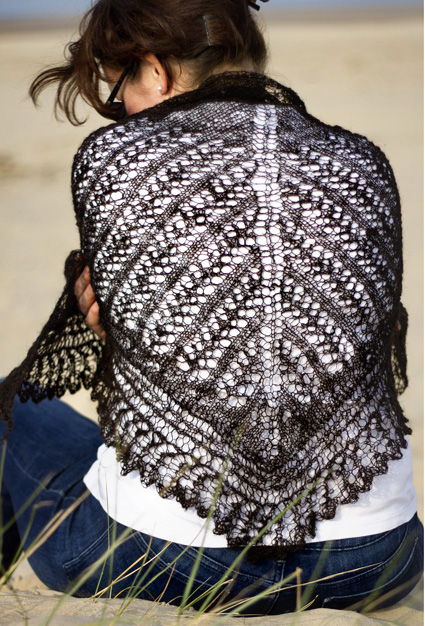

|
|
|

Ridge and Furrow is the result of making classic mistake and that moment of inspiration that you just have to see it through to the end. My walk to the local farm to check out their fleece took me through a freshly ploughed field. I was inspired by the pattern of the ridges and furrows through the field and the rich chocolate brown of the earth. |
||
|
|
||
|
SIZE |
|
|
FINISHED MEASUREMENTS |
|
MATERIALS
Tools |
|||||
|
GAUGE |
| 18 sts/32 rows = 4 inches in stockinette stitch 18 sts/26 rows = 4 inches in pattern stitch (according to Chart 1 fully open after washing and blocking) Correct gauge is not essential for this project, however working at a different gauge will affect both the look and the yarn usage. |
|
PATTERN NOTES |
|
This is a modular pattern. The main body stocking stitch and 4 row linear lace pattern can be made smaller or larger to give a smaller shoulderette or larger shawl as required. The edging is worked on the resulting live stitches so will fit whatever size. This project uses a provisional cast on. Use your preferred technique; directions for one may be found here. 3 into 3 star: K3tog without dropping sts from left needle, yo, k same 3 sts together again and drop from left needle. Keep edging stitches and cast on and cast off stitches very loose to help with the blocking. Either pull the yarn into a big sloppy stitch if you are good at being consistent, or alternatively wrap the yarn around the needle when working the stitch, remembering to slip all off needle before working. The slipped stitch at the edges are to keep everything loose for blocking. |
|
The charts for this pattern are very large and fit on a letter-sized page. Click here and print the resulting page. |
|
DIRECTIONS Row 1: Sl 1, k2. At end of last row, turn work 90 degrees clockwise and pick up and k 5 sts along the long edge of work, skipping the first slipped stitch of the edge. Row 1 [WS]: Knit. Establish Body Lace pattern Row 2 [WS]: Sl 1, k2, work Chart 1 to first marker, k1, work Chart 1 to last 3 sts, k3. Work as set until you have worked Chart 1 twice, and work Rows 1-4 once more. 263 sts total, 128 in each lace portion. Transition to Border: Note: the 3 into 3 star should line up with the 3 stitch ridge pattern lines formed between to the lace pattern and make a pretty flower motif end point to the ridges. Lace Border: Setup for border [RS]: BO 3 sts, leaving final st live on the needle. Turn work so that WS is facing. Work garter stitch border joining to lace edge stitches: Repeat Rows 1-2 until all sts of edging have been decreased away. 3 sts rem total. BO rem 3 sts. |
|
FINISHING |
| ABOUT THE DESIGNER |
|
Jenn lives in Norfolk where she dyes, spins and knits and stares at the big blue skies waiting for inspiration to strike. She can be found at fibreworkshop.co.uk and on Ravelry. |
|
Pattern & images © 2015 Jenn Monahan. Contact Jenn |